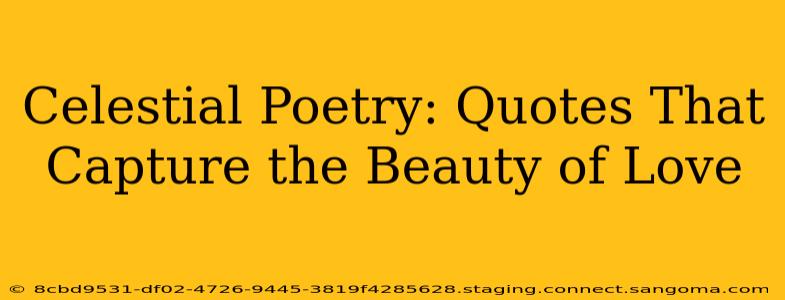Love, a force as vast and mysterious as the cosmos itself, has inspired poets, songwriters, and artists for millennia. Its celestial nature—a boundless expanse of emotion, wonder, and connection—often finds expression in imagery drawn from the stars, moon, and heavens. This exploration delves into the celestial poetry of love, examining quotes that capture its ethereal beauty and profound impact. We'll uncover the enduring power of these words, showing how they resonate with our deepest feelings and illuminate the universal experience of love.
What are some famous celestial love quotes?
Many renowned poets and writers have used celestial imagery to express the depth and intensity of love. Here are some prominent examples:
-
"Love is like the moon, sometimes full, sometimes new." This simple yet poignant quote captures the cyclical nature of relationships, highlighting the ebb and flow of intimacy and connection. The moon's phases mirror the changing dynamics within a loving partnership.
-
"My love for you is a constellation, infinite and ever-expanding." This quote beautifully utilizes the imagery of a constellation to depict the boundless nature of love. Just as a constellation contains countless stars, love encompasses a multitude of emotions, experiences, and memories.
-
"You are the sun, and I am the Earth, forever orbiting your warmth and light." This quote uses a powerful astronomical metaphor to represent the dependence and devotion within a loving relationship. The Earth's constant orbit around the sun mirrors the commitment and unwavering devotion found in true love.
-
"Our love is a shooting star, a fleeting moment of brilliance etched forever in the night sky." This quote evokes a sense of wonder and fleeting beauty. The image of a shooting star signifies the preciousness and ephemeral nature of certain romantic encounters, yet the "etched forever" element emphasizes the lasting memory and impact.
How can I write a celestial love poem?
Writing a celestial love poem requires tapping into the vast symbolic potential of the night sky. Consider the following:
-
Select your celestial imagery: Do you want to focus on the moon's soft glow, the sun's radiant warmth, the twinkling of stars, or the dramatic sweep of a comet? The choice of imagery will heavily influence the tone and emotional impact of your poem.
-
Establish a metaphorical connection: Don't just describe the celestial elements; use them to represent aspects of your love. For example, the moon could symbolize your lover's enchanting mystique, while the stars might represent the countless moments of joy shared.
-
Employ vivid language and sensory details: Engage the reader's imagination through precise and evocative language. Describe the texture of moonlight, the warmth of the sun's rays, or the shimmering brilliance of distant stars.
-
Structure your poem effectively: Consider using traditional poetic forms like sonnets or free verse to structure your thoughts and create a rhythmic flow.
-
Embrace personal expression: The most powerful poems are those that spring from authentic personal experiences. Allow your emotions to guide your writing, and let your love shine through.
What are some examples of celestial imagery in literature and art?
Celestial imagery has been a powerful tool for artists and writers throughout history. From Shakespeare's sonnets to romantic paintings depicting lovers beneath a starry sky, the symbolism of the cosmos in expressing love is pervasive. Think of the countless romantic paintings where lovers are depicted gazing at a starlit sky, or the poems that compare a beloved's eyes to distant stars. These examples showcase the enduring appeal of celestial imagery as a means of portraying the magnitude and wonder of love.
What does it mean when someone says their love is like the stars?
When someone describes their love as being "like the stars," it often conveys a sense of vastness, permanence, and enduring beauty. Stars, with their immense distance and timeless presence, symbolize a love that transcends the mundane and possesses a lasting quality. The twinkling of stars can further represent the joy and excitement within the relationship. In essence, it's a metaphor for a love that is both profound and enduring.
By exploring these celestial metaphors and examples, we hope to have illuminated the beauty and enduring power of love's celestial representation in poetry and beyond. The cosmos, in its infinite expanse, offers a rich tapestry of symbols to express the depth, complexity, and enduring power of the human heart's most profound emotion.

